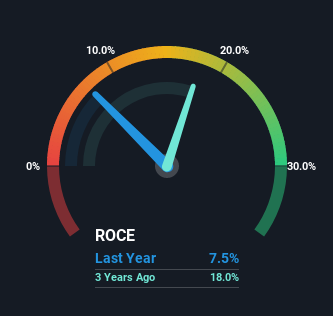- India
- /
- Oil and Gas
- /
- NSEI:HINDPETRO
Here's What's Concerning About Hindustan Petroleum's (NSE:HINDPETRO) Returns On Capital

There are a few key trends to look for if we want to identify the next multi-bagger. Ideally, a business will show two trends; firstly a growing return on capital employed (ROCE) and secondly, an increasing amount of capital employed. Basically this means that a company has profitable initiatives that it can continue to reinvest in, which is a trait of a compounding machine. Although, when we looked at Hindustan Petroleum (NSE:HINDPETRO), it didn't seem to tick all of these boxes.
What is Return On Capital Employed (ROCE)?
For those that aren't sure what ROCE is, it measures the amount of pre-tax profits a company can generate from the capital employed in its business. To calculate this metric for Hindustan Petroleum, this is the formula:
Return on Capital Employed = Earnings Before Interest and Tax (EBIT) ÷ (Total Assets - Current Liabilities)
0.075 = ₹62b ÷ (₹1.5t - ₹714b) (Based on the trailing twelve months to March 2022).
So, Hindustan Petroleum has an ROCE of 7.5%. Ultimately, that's a low return and it under-performs the Oil and Gas industry average of 11%.
Check out our latest analysis for Hindustan Petroleum

In the above chart we have measured Hindustan Petroleum's prior ROCE against its prior performance, but the future is arguably more important. If you're interested, you can view the analysts predictions in our free report on analyst forecasts for the company.
So How Is Hindustan Petroleum's ROCE Trending?
In terms of Hindustan Petroleum's historical ROCE movements, the trend isn't fantastic. Over the last five years, returns on capital have decreased to 7.5% from 23% five years ago. Although, given both revenue and the amount of assets employed in the business have increased, it could suggest the company is investing in growth, and the extra capital has led to a short-term reduction in ROCE. If these investments prove successful, this can bode very well for long term stock performance.
On a related note, Hindustan Petroleum has decreased its current liabilities to 46% of total assets. That could partly explain why the ROCE has dropped. What's more, this can reduce some aspects of risk to the business because now the company's suppliers or short-term creditors are funding less of its operations. Some would claim this reduces the business' efficiency at generating ROCE since it is now funding more of the operations with its own money. Keep in mind 46% is still pretty high, so those risks are still somewhat prevalent.
What We Can Learn From Hindustan Petroleum's ROCE
Even though returns on capital have fallen in the short term, we find it promising that revenue and capital employed have both increased for Hindustan Petroleum. However, despite the promising trends, the stock has fallen 15% over the last five years, so there might be an opportunity here for astute investors. So we think it'd be worthwhile to look further into this stock given the trends look encouraging.
One more thing to note, we've identified 4 warning signs with Hindustan Petroleum and understanding these should be part of your investment process.
For those who like to invest in solid companies, check out this free list of companies with solid balance sheets and high returns on equity.
Valuation is complex, but we're here to simplify it.
Discover if Hindustan Petroleum might be undervalued or overvalued with our detailed analysis, featuring fair value estimates, potential risks, dividends, insider trades, and its financial condition.
Access Free AnalysisHave feedback on this article? Concerned about the content? Get in touch with us directly. Alternatively, email editorial-team (at) simplywallst.com.
This article by Simply Wall St is general in nature. We provide commentary based on historical data and analyst forecasts only using an unbiased methodology and our articles are not intended to be financial advice. It does not constitute a recommendation to buy or sell any stock, and does not take account of your objectives, or your financial situation. We aim to bring you long-term focused analysis driven by fundamental data. Note that our analysis may not factor in the latest price-sensitive company announcements or qualitative material. Simply Wall St has no position in any stocks mentioned.
About NSEI:HINDPETRO
Hindustan Petroleum
Engages in the refining and marketing of petroleum products in India and internationally.
Average dividend payer with moderate growth potential.

